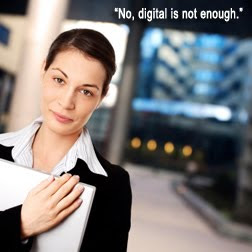 There's a secret about social media that I thought you might like to know. You'll never get anywhere doing what experts tell you to do.
There's a secret about social media that I thought you might like to know. You'll never get anywhere doing what experts tell you to do.This is true for Facebook. And it's true for Twitter. It's certainly true for blogs. And it's also true for Digg, StumbleUpon and Reddit. Heck, it's true for any social network or social media tool that your company has its eye on. If you follow the leaders, you will eventually lose.
There Is No Formula For Everyone To Follow.
It's not really about social media per se. It's about human nature. The more things become the same, the more people want someone to drift away from all the sameness. It's why music and art tend to flow in cycles. Ergo, Nirvana opened up grunge until grunge became saturated. Minimalist art had people buying two-tone canvases until Andy Warhol pushed up pop.
It happens in almost every industry. It's even the primary reason newspapers and television news started to struggle. It wasn't so much that social media swept the scene as much as it was that they were reporting on the same things, day after day and year after year. News needed a fresh perspective and social media just happened to be the method of delivery.
Social media experts are doing it now too. As the number of experts has increased exponentially, there are proportionately fewer who don't jump on the the most obvious topical bandwagons (and then sometimes lament that someone "followed" them without credit). Seriously?
Of course everyone is spinning the five-step crisis communication solution to the tragedy du jour. Of course everyone is covering the Delicious shift. Of course everyone wants to talk about the iPad 2. Naturally, most people want to discuss the demise of MyBlogLog. Oh wait, not that one. Some people are embarrassed to mention it.
The point being is that most bloggers and social networkers, commercial or otherwise, have a tendency to follow in everyone else's footsteps. It's what they know. They've been watching the sameness factor of traditional media for too long. It's rubbed off on them.
Nobody wants to be the one person caught not covering something. So it stands to reason that the slowest high-speed chase in history locked every channel into live coverage of a white Suburban on cruise control. Yawn.
There Is No Social Media Formula, Results May Vary.
I've worked on about two dozen social media accounts. Not one of them has been the same, even if they used some of the same tools (sometimes they did not). But that's because I appreciate that social media doesn't drive effective content management. Strategic communication drives effective content management — finding the balance between the core of a company (mission, vision, values) and some objective. (And none of it has to do with eyeballs.)
Sure, there are people who would like to tell you differently. Public relations, for example, likes to add formula pushing the message. Social networks like to follow each other, until the social network eventually fails. And social media experts like to add relevancy to scoring systems that aren't relevant. (Um, Empire Avenue is just a flippin' game, not something that needs to be gamed.)
Geoff Livingston distinguishes the approach between machine gunners and garners. Chris Guillebeau frames it up as a cure for a starving artist. And Julien Smith packages similar advice in a way that only Smith can do.
The secret to social media isn't knowing what everyone else is doing so you can do it. It's knowing what everyone else is doing so that you can do something else.
The Better Way To Build A Social Media Effort.
About a year ago, I was contacted by a specialty contractor who was savvy enough to appreciate that his startup might have a competitive advantage with a social media program, but I passed on the job. The reason I passed was because he sent over a dozen or so links and asked that I create a social media program based on others that he "liked."
 Of course, I didn't say no outright. I only said no after he insisted I develop a social media program that would undermine his company's core and primary objective, and was predestined to be an exercise in boredom.
Of course, I didn't say no outright. I only said no after he insisted I develop a social media program that would undermine his company's core and primary objective, and was predestined to be an exercise in boredom.You see, as a specialty contractor, he wanted to demonstrate that his firm was creative and different (core). He also had an objective of attracting architects, designers, and creative general contractors — people who are often brought in on the projects first and then refer or bring in people like him (objective).
My solution was different than what he expected. I suggested rather than be like everybody else (push content about his company and opinions), he might want to develop content about the people he wanted to attract. In other words, his program would be underpinned by the great creative work of his prospects.
"But," he frowned. "That might mean giving exposure to my competitors too."
Ho hum. I just didn't have it in me to write marketing copy that masqueraded as social content. So, I suggested he contact a firm that was much more formulaic or attempt to do it himself. I'm not sure what he decided, but I know nobody reads the content.
Why would they? Just like the dozen or so programs he liked, his company has a blog that is nothing much more than a serialized "about me" page. You know, just like everybody else, which speaks volumes about his company. He's just like everybody else, no matter how many times he says otherwise.

























